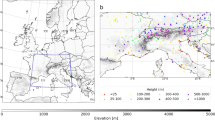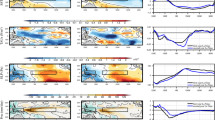Abstract
Surface winds are crucial for accurately modeling the surface circulation in the coastal ocean. In the present work, high-frequency radar surface currents are assimilated using an ensemble scheme which aims to obtain improved surface winds taking into account European Centre for Medium-Range Weather Forecasts winds as a first guess and surface current measurements. The objective of this study is to show that wind forcing can be improved using an approach similar to parameter estimation in ensemble data assimilation. Like variational assimilation schemes, the method provides an improved wind field based on surface current measurements. However, the technique does not require an adjoint, and it is thus easier to implement. In addition, it does not rely on a linearization of the model dynamics. The method is validated directly by comparing the analyzed wind speed to independent in situ measurements and indirectly by assessing the impact of the corrected winds on model sea surface temperature (SST) relative to satellite SST.






Similar content being viewed by others
References
Aksoy A, Zhang F, Nielsen-Gammon JW (2006) Ensemble-based simultaneous state and parameter estimation with MM5. Geophys Res Lett 33:L12801
Anderson JL (2001) An ensemble adjustment filter for data assimilation. Mon Weather Rev 129:2884–2903
Annan J, Lunt D, Hargreaves J, Valdes P (2005) Parameter estimation in an atmospheric GCM using the ensemble Kalman filter. Nonlinear Processes Geophys 12:363–371
Barrick D, Evans M, Weber B (1977) Ocean surface currents mapped by radar. Science 198:138–144
Barth A, Alvera-Azcárate A, Beckers JM, Rixen M, Vandenbulcke L (2007) Multigrid state vector for data assimilation in a two-way nested model of the Ligurian Sea. J Mar Syst 65(1–4):41–59. doi:10.1016/j.jmarsys.2005.07.006. http://hdl.handle.net/2268/4260
Barth A, Alvera-Azcárate A, Weisberg RH (2008) Assimilation of high-frequency radar currents in a nested model of the West Florida Shelf. J Geophys Res 113:C08033. doi:10.1029/2007JC004585. http://hdl.handle.net/2268/26171
Barth A, Alvera-Azcárate A, Gurgel KW, Staneva J, Port A, Beckers JM, Stanev EV (2010) Ensemble perturbation smoother for optimizing tidal boundary conditions by assimilation of high-frequency radar surface currents—application to the German Bight. Ocean Sci 6(1):161–178. doi:10.5194/os-6-161-2010. http://www.ocean-sci.net/6/161/2010/
Béal D, Brasseur P, Brankart JM, Ourmières Y, Verron J (2010) Characterization of mixing errors in a coupled physical biogeochemical model of the North Atlantic: implications for nonlinear estimation using Gaussian anamorphosis. Ocean Sci 6:247–262. doi:10.5194/os-6-247-2010
Brankart JM, Testut CE, Brasseur P, Verron J (2003) Implementation of a multivariate data assimilation scheme for isopycnic coordinate ocean models: application to a 1993–96 hindcast of the North Atlantic Ocean circulation. J Geophys Res 108(C3):3074. doi:10.1029/2001JC001198
Breivik O, Satra O (2001) Real time assimilation of HF radar currents into a coastal ocean model. J Mar Syst 3–4:161–182
Burchard H, Bolding K (2002) GETM—a general estuarine transport model. Scientific documentation. Tech. Rep. EUR 20253 EN, European Commission
Chen Y, Snyder C (2007) Assimilating vortex position with an ensemble Kalman filter. Mon Weather Rev 135:1828–1845
Evensen G (1994) Sequential data assimilation with a nonlinear quasi-geostrophic model using Monte Carlo methods to forecast error statistics. J Geophys Res 99(C5):10143–10162
Evensen G (2003) The ensemble Kalman filter: theoretical formulation and practical implementation. Ocean Dyn 53:343–367. doi:10.1007/s10236-003-0036-9
Evensen G (2007) Data assimilation: the ensemble Kalman filter. Springer, New York, p 279
Gelb A (1974) Applied optimal estimation. MIT, Cambridge, p 374
Greenwald TJ, Hertenstein R, Vukićević T (2002) An all-weather observational operator for radiance data assimilation with mesoscale forecast models. Mon Weather Rev 130:1882–1897
Hamill TM, Whitaker JS, Snyder C (2001) Distance-dependent filtering of background error covariance estimates in an ensemble Kalman filter. Mon Weather Rev 129:2776–2790
He R, Liu Y, Weisberg RH (2004) Coastal ocean wind fields gauged against the performance of an ocean circulation model. Geophys Res Lett 31:L14303. doi:10.1029/2003GL019261
Hoteit I, Cornuelle BD, Kim SY, Forget G, Köhl A, Terrill EJ (2009) Assessing 4D-VAR for dynamical mapping of coastal high-frequency radar in San Diego. Dyn Atmos Oceans 48:175–197. doi:10.1016/j.dynatmoce.2008.11.005
Hunt BR, Kalnay E, Kostelich EJ, Ott E, Patil DJ, Sauer T, Szunyogh I, Yorke JA, Zimin AV (2004) Four-dimensional ensemble Kalman filtering. Tellus 56A:273–277
Hunt BR, Kostelich EJ, Szunyogh I (2007) Efficient data assimilation for spatiotemporal chaos: A local ensemble transform Kalman filter. Physica D 230:112–126
Kundu PK (1976) Ekman veering observed near the ocean bottom. J Phys Oceanogr 6:238–242
Kurapov AL, Egbert GD, Allen JS, Miller RN, Erofeeva SY, Kosro P (2003) The M2 internal tide off Oregon: inferences from data assimilation. J Phys Oceanogr 33:1733–1757
van Leeuwen PJ (2001) An ensemble smoother with error estimates. Mon Weather Rev 129:709–728
Lewis JK, Shulman I, Blumberg AF (1998) Assimilation of CODAR observations into ocean models. Cont Shelf Res 18:541–559
Ljung L (1979) Asymptotic behavior of the extended Kalman filter as a parameter estimator for linear systems. IEEE Trans Autom Control 24:36–50
Losa SN, Kivman GA, Schroter J, Wenzel M (2003) Sequential weak constraint parameter estimation in an ecosystem model. J Mar Syst 43:31–49
Lucas MA, Ayoub N, Barnier B, Penduff T, de Mey P (2008) Stochastic study of the temperature response of the upper ocean to uncertainties in the atmospheric forcing in an Atlantic OGCM. Ocean Model 20:90–113. doi:10.1016/j.ocemod.2007.07.006
Malanotte-Rizzoli P, Young RE, Haidvogel DB (1989) Initialization and data assimilation experiments with a primitive equation model. Dyn Atmos Oceans 13:349–378
Menemenlis D, Fieguth P, Wunsch C, Willsky A (1997) Adaptation of a fast optimal interpolation algorithm to the mapping of oceanographic data. J Geophys Res 102(C5):10573–10584
Mourre B, Ballabrera-Poy J, Garcia-Ladona E, Font J (2008) Surface salinity response to changes in the model parameters and forcings in a climatological simulation of the eastern North-Atlantic Ocean. Ocean Model 23:21–32
Oke PR, Allen JS, Miller RN, Egbert GD, Kosro PM (2002) Assimilation of surface velocity data into a primitive equation coastal ocean model. J Geophys Res 107(C9):5-1–5-25
Paduan JD, Shulman I (2004) HF radar data assimilation in the Monterey Bay area. J Geophys Res 109:C07S09
Pham DT, Verron J, Roubaud MC (1998) A singular evolutive extended Kalman filter for data assimilation in oceanography. J Mar Syst 16(3–4):323–340
PRISMA (1994) Prozesse im Schadstoffkreislauf Meer-Atmosphäre: Ökosystem Deutsche Bucht. BMFT-Projekt 03F0558A1 (1.1.1990–31.10.1993). Abschlussbericht, ZMK-Universität Hamburg
Sakov P, Evensen G, Bertino L (2010) Asynchronous data assimilation with the EnKF. Tellus 62A:24–29
Shulman I, Paduan JD (2009) Assimilation of HF radar-derived radials and total currents in the Monterey Bay area. Deep Sea Res II: Topical Studies in Oceanography 56(3–5):149–160. doi:10.1016/j.dsr2.2008.08.004
Skachko S, Brankart JM, Castruccio F, Brasseur P, Verron J (2009) Improved turbulent air-sea flux bulk parameterization for controlling the response of the ocean mixed layer: a sequential assimilation approach. J Atmos Ocean Technol 26:538–555
Skandrani C, Brankart JM, Ferry N, Verron J, Brasseur P, Barnier B (2009) Controlling atmospheric forcing parameters of global ocean models: sequential assimilation of sea surface Mercator-Ocean reanalysis data. Ocean Sci 5:1–15
Staneva J, Stanev EV, Wolff JO, Badewien TH, Reuter R, Flemming B, Bartholomä A, Bolding K (2009) Hydrodynamics and sediment dynamics in the German Bight. A focus on observations and numerical modelling in the East Frisian Wadden Sea. Cont Shelf Res 29:302–319
Talagrand O (1972) On the damping of high-frequency motions in four-dimensional assimilation of meteorological data. J Atmos Sci 29:1571–1547
Vandenbulcke L, Rixen M, Beckers JM, Alvera-Azcárate A, Barth A (2008) An analysis of the error space of a high-resolution implementation of the GHER hydrodynamic model in the Mediterranean Sea. Ocean Model 24(1–2):46–64. doi: 10.1016/j.ocemod.2008.05.007. http://hdl.handle.net/2268/4263
Wilkin JL, Arango HG, Haidvogel DB, Lichtenwalner CS, Glenn SM, Hedström KS (2005) A regional ocean modeling system for the Long-term Ecosystem Observatory. J Geophys Res 110:C06S91
Acknowledgements
Klaus-Werner Gurgel from the University of Hamburg is thanked for providing the HF radar observations. The National Fund for Scientific Research, Belgium is acknowledged for funding the post-doctoral positions of the two first authors. This work was supported by the ECOOP project (European Coastal-shelf sea Operational observing and forecasting system) of the European Union. AVHRR Oceans Pathfinder SST data were obtained through the online PO.DAAC Ocean ESIP Tool (POET) at the Physical Oceanography Distributed Active Archive Center (PO.DAAC), NASA Jet Propulsion Laboratory, Pasadena, CA (http://podaac.jpl.nasa.gov/poet). Wind observations were obtained through the Web-based Weather Request and Distribution System from the German Meteorological Service (Deutscher Wetterdienst). We thank also two anonymous referees for their valuable comments and their constructive suggestions. This is a MARE publication.
Author information
Authors and Affiliations
Corresponding author
Additional information
Responsible Editor: Pierre-Marie Poulain
This article is part of the Topical Collection on Multiparametric observation and analysis of the Sea
Appendix: Analysis update for non-linear observation operators
Appendix: Analysis update for non-linear observation operators
The background estimate x b and the observations y o (involving a possibly non-linear observation operator h(·)) are assumed to be an unbiased estimate of the true state x t.
The error of the background estimate x b and the observations y o are assumed to be independent. One seeks an analysis scheme of the following form,
where K is a matrix to be defined by requiring that the analysis has a minimal error. On average, the analysis should be unbiased.
This is the case if:
The error of the analysis is given by:
Since the background estimate is independent from the observations, h(x b) is also independent from the observations (\(\mbox{cov}({\bf y}^o,h({\bf x}^b)) = 0\)). The error covariance of the analysis yields:
Covariances are approximated by the ensemble covariances:
The optimal Kalman gain K is obtained by minimizing the total error \(\mbox{tr}({\bf W} {\bf P}^a)\) where W is an arbitrary weighting matrix.
The minimum is obtained by:
δJ is zero for any δ K if,
In summary, the analysis update with a non-linear observation operator is not guaranteed to be unbiased. The condition of Eq. 18 has thus to be verified separately. The Kalman gain can then be derived without additional assumptions (compared to the case of a linear observation operator).
In the context of the extended Kalman filter, a non-linear observation operator h(·) is linearized around the model forecast. Such linearization is not necessary here because the covariance matrices in the extended Kalman filter H P b H T and P b H T are directly derived from the ensemble (\(\mbox{cov}(h({\bf x}^b),h({\bf x}^b))\) and \(\mbox{cov}({\bf x}^b,\) h(x b))).
Rights and permissions
About this article
Cite this article
Barth, A., Alvera-Azcárate, A., Beckers, JM. et al. Correcting surface winds by assimilating high-frequency radar surface currents in the German Bight. Ocean Dynamics 61, 599–610 (2011). https://doi.org/10.1007/s10236-010-0369-0
Received:
Accepted:
Published:
Issue Date:
DOI: https://doi.org/10.1007/s10236-010-0369-0




